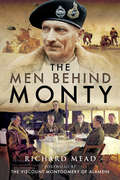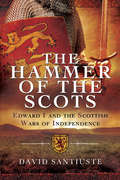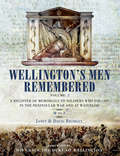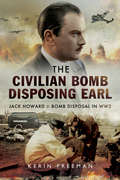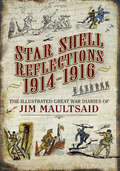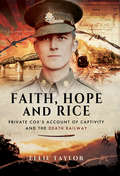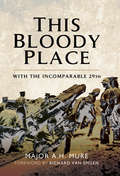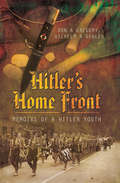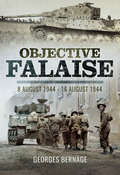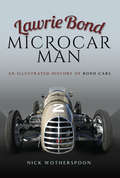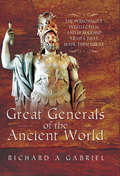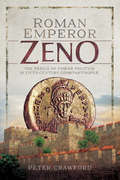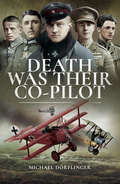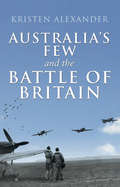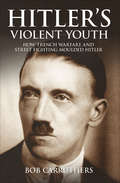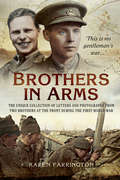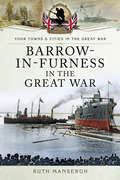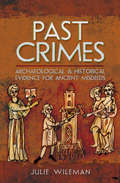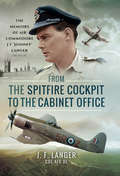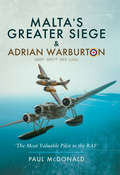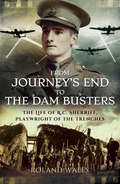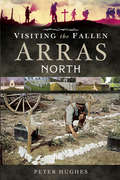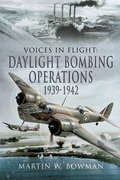- Table View
- List View
The Men Behind Monty
by Richard MeadThe Men Behind Monty examines the role played by the staff in the victorious campaigns of Field Marshal Viscount Montgomery, Britain's most successful field commander since the Duke of Wellington.When Monty took command of Eighth Army in August 1942, he inherited the staff of his predecessor. He retained all the key members and most of them stayed with him not only from El Alamein to Tunis, but also in Sicily and Italy. When he took command of 21st Army Group in January 1944, many accompanied him to take up the most prominent positions on the HQ staff and the majority remained until the German surrender in May 1945.This fascinating work focuses not only on the senior officers responsible for the various staff branches, and notably on Monty's outstanding Chief of Staff, Freddie de Guingand, but also on his personal staff, the ADCs and personal liaison officers.The book sheds light on the work of the staff generally, and on their direct contribution to Monty's decisions, his sometimes difficult and controversial relationships with his superiors and allies.
The Hammer of the Scots: Edward I and the Scottish Wars of Independence
by David SantiusteKnown to posterity as Scottorum Malleus - the Hammer of the Scots - Edward I was one of medieval England's most formidable rulers. In this meticulously researched new history, David Santiuste offers a fresh interpretation of Edward's military career, with a particular focus on his Scottish wars. This is in part a study of personality: Edward was a remarkable man. His struggles with tenacious opponents - including Robert the Bruce and William Wallace - have become the stuff of legend.There is a clear and perceptive account of important military events, notably the Battle of Falkirk, but the narrative also encompasses the wider impact of Edward's campaigns. He attempted to mobilize resources - including men, money and supplies - on an unprecedented scale. His wars affected people at all levels of society, throughout the British Isles.David Santiuste builds up a vivid and convincing description of Edward's campaigns in Scotland, whilst also exploring the political background. Edward emerges as a man of great conviction, who sought to bend Scotland to his will, yet also, on occasion, as a surprisingly beleaguered figure. He is presented here as the central character in a turbulent world, as commander and king.
Wellington's Men Remembered Volume 2: A Register of Memorials to Soldiers Who Fought in the Peninsular War and at Waterloo: M to Z
by David Bromley Janet BromleyWellington's Men Remembered is a reference work which has been compiled on behalf of the Association of Friends of the Waterloo Committee and contains over 3,000 memorials to soldiers who fought in the Peninsular War and at Waterloo between 1808 and 1815, together with 150 battlefield and regimental memorials in 24 countries worldwide.
The Civilian Bomb Disposing Earl: Jack Howard and Bomb Disposal in WW2
by Kerin FreemanCharles 'Jack' Henry George Howard, GC, 20th Earl of Suffolk & Berkshire, born into the noble formidable House of Howard, possessed extraordinary courage. Jack became an earl at the age of eleven after his father died in WWI in Mesopotamia. At age thirty-four, Jack's courageous spirit led him to execute a daring mission for the British government in 1940 in Paris. Under the noses of the advancing Germans he snatched top French scientists, millions of pounds worth of diamonds, armaments, heavy water (the only kind in the world), and secret documents. His trip back to England from Bordeaux was fraught with danger in mine and submarine infested waters. His mission remained Top Secret throughout the war years and beyond, even to his closest family. His adventure in Paris earned him the nickname of 'Mad Jack'. His next chosen mission was again of prime importance and extremely dangerous, a secret more closely guarded than radar. He began working in bomb disposal in close proximity with his secretary Beryl, and Fred his chauffeur, and the three became widely known as The Holy Trinity. Whenever an unexploded bomb was reported, it was quickly brought to the Earl's attention, especially if it was tricky. Thirty four bombs were successfully defuzed by The Holy Trinity and their loyal team of Royal Engineers. The thirty-fifth bomb blew them up.The Holy Trinity were the only World War II civilian casualties working in Bomb Disposal. King George VI in 1941 awarded the 20th Earl the George Cross for his work for his country, the highest gallantry award for civilians, as well as for members of the armed forces, in actions for which purely military honours would not normally be granted.
Star Shell Reflections, 1914–1916: The Illustrated Great War Diaries of Jim Maultsaid
by Jim MaultsaidAs the centenary of the Great War approaches, this book offers a unique perspective told in the words and illustrations of someone who was there , on the front line.Although an American citizen, Jim Maultsaid's parents were Irish and he lived in Donegal. He joined the Young Citizen Volunteers, a group drawn from the ranks of clerical and professional society, at the outbreak of war.Although he left school at age 13, the author was naturally gifted in both writing and drawing, with a great eye for detail, and has often been described as the unofficial war artist.Jim's personal style of writing is engaging, and along with his sketches and illustrations, which are witty at times, takes the reader on a journey through not only the dark days and misery but also reveals the gritty humour that helped him and his 'chums' cope with the horrors of life in the trenches.The diaries offer in words and illustrations, a true insight into the thoughts of the ordinary soldiers, and are filled with untold stories from the Great War, covering aspects that have never been addressed in other books. In particular there is new light shone on the Chinese Labour Corps, where Jim served as Captain, after he was certified unfit for active service due to his wounds.The book has great historical and educational value, and will give those of all ages a real understanding of how this brave generation faced war, and how they struggled to survive.
Faith, Hope and Rice: Private Cox's Account of Captivity and the Death Railway
by Ellie TaylorFred Cox, a young soldier in the East Surrey Regiment, was taken prisoner by the Japanese at the fall of Singapore in February 1942. The next three and a half years were spent in a series of PoW camps, notably in Thailand working on the aptly named Death Railway. Fortunately he was not one of the 12,000 Allied prisoners who perished as a result of extreme maltreatment, starvation or disease, but his health, both physical and psychological, was seriously affected. After liberation, whilst in hospital in Ceylon, Fred was nursed by Joan whom he married. Advised by the doctors to face his horrific experiences, he and Joan spent the winter of 1946 1947 getting his story down on paper. Seventy years on, sadly after his death, Faith, Hope and Rice, (which were what sustained Fred through his ordeal) can now be shared with a wider audience. Readers cannot fail to be moved by the author's and his comrades' inspiring courage and resilience in the face of extreme adversity and ever present death.
This Bloody Place: With the Incomparable 29th
by Major A.H. MureCaptain Albert Mure, a company commander in the 5th Battalion The Royal Scots, spent forty-three days in Gallipoli - far longer than many men who fought there would survive. In those few weeks, this brave, stoical officer was reduced from a fit, determined leader of men to a physical and mental wreck. In simple and honest language, Mure conveys the drama of the first landings, knowing that very shortly afterwards he and his men would be ashore and experiencing the same fate; his sympathy for those under his command is clear. Although suffering from shell shock, when the time came for him to leave the peninsular, he nevertheless felt like a deserter, remarking that, 'you can carry a no-longer-fit soldier's body out of the firing-line, but not his soul.' Originally published in 1919, Mure's story of his experiences at Gallipoli is full of a rawness and immediacy that I believe makes it worthy of a place amongst the many Great War memoirs.
Hitler's Home Front: Memoirs of a Hitler Youth
by Don A Gregory Wilhelm R GehlenA &“candid and revealing memoir shows a normal boy and a family at war and in its aftermath, determined to do what it took to survive . . . fascinating&” (The Great War). When Adolf Hitler and the Nazi Party came into power in 1933, he promised the downtrodden, demoralized, and economically broken people of Germany a new beginning and a strong future. Millions flocked to his message, including a corps of young people called the Hitlerjugend—the Hitler Youth. By 1942 Hitler had transformed Germany into a juggernaut of war that swept over Europe and threatened to conquer the world. It was in that year that a nine-year-old Wilhelm Reinhard Gehlen, took the &‘Jungvolk&’ oath, vowing to give his life for Hitler. This is the story of Wilhelm Gehlen&’s childhood in Nazi Germany during World War II and the awful circumstances which he and his friends and family had to endure during and following the war. Including a handful of recipes and descriptions of the strange and sometimes disgusting food that nevertheless kept people alive, this book sheds light on the truly awful conditions and the twisted, mistaken devotion held by members of the Hitler Youth—that it was their duty to do everything possible to save the Thousand Year Reich.
Objective Falaise: 8 August 1944–16 August 1944
by Georges BernageOn the night of 8 August 1944, the First Canadian Army launched Operation Totalize, directing their advance towards Falaise, with the intention of breaking through the German defences south of Caen. In spite of large numbers, they were halted by the 12.SS- Panzer-Division "Hitierjugend", who managed to block the 600 armored vehicles. During one of the German counter-attacks, several Tiger tanks were destroyed, including that of panzer ace, Michael Wittmann, who was killed in the process.The offensive was relaunched a few days later under the name Operation Tractable, the intention this time being to capture the strategically important town of Falaise and close the 'Falaise Pocket', also known as the 'Corridor of Death'.This book provides the reader with a day-by-day account of this forgotten battle, while also acting as a field guide, including maps and both comtemporary and modern photographs.
Lawrie Bond, Microcar Man: An Illustrated History of Bond Cars
by Nick WotherspoonOnce a common sight on Britain's roads, few people today seem to have heard of the Bond Minicar not a diminutive, gadget laden conveyance for the fictional 007 character, but a popular, practical, motorcycle-engined, three-wheeler that in the post-war austerity period, gave tens of thousands of people affordable personal transport at a time when conventional vehicles were beyond the reach of the average household. Yet whilst the later, mostly imported, 'Bubble cars' have remained in the public eye, it is largely forgotten that the first of the postwar 'Microcars' to go into significant production was the British designed and built Bond. Equally enigmatic seems to be the designer of this vehicle, Lawrence 'Lawrie' Bond a prolific automotive design genius, with a penchant for weight-saving construction techniques. He was responsible for a wide range of two, three and four wheel vehicles; from ultra-lightweight motorcycles and scooters, such as the Minibyke, Lilliput and Gazelle, as well as his other Microcars the stylish Berkeley and perhaps less-than-pretty Opperman Unicar and finally to his later work, including the innovative, but troubled Bond 875 and styling the Equipe GT sportscar.Here the story is told in full, covering all Lawrie's innovative designs and the various vehicles that bore his name, all in prolifically illustrated detail, together with his passion for motor racing, which resulted in a number of technically acclaimed racing cars, some of which can still be seen competing is historic racing events today.
Great Generals of the Ancient World: The Personality, Intellectual and Leadership Traits That Made Them Great
by Richard A. GabrielThe military expert and author of Philip II of Macedonia presents 9 profiles of exemplary leadership from the ancient world. Of all the military commanders throughout history, only a few are remembered as great leaders of men in battle. Is there a combination of personal attributes and historical circumstances that produces great commanders? Professor Richard A. Gabriel analyses the biographies of ten great generals, all of whom lived between 1481 BC and AD 632, in order to identify the characteristics of intellect, psychology, personality, and experience that allowed them to tread the path to greatness. Some of the names included in Gabriel&’s selection, such as Moses and Muhammad, will surprise many readers—as will the historical figures Gabriel chooses to omit, including Alexander the Great and Atilla the Hun. But Gabriel is not merely interested in famous military exploits. A retired soldier and professor at the Canadian Defence College, he distils the timeless essence of military leadership through the examples of Julius Caesar, Philip II of Macedonia, Thutmose III of Egypt, and others
Roman Emperor Zeno: The Perils of Power Politics in Fifth-Century Constantinople
by Peter Crawford&“A very useful read for anyone interested in the Later Roman Empire, the fall of the Western Empire, and the emergence of the Byzantine State.&” —The NYMAS Review Peter Crawford examines the life and career of the fifth-century Roman emperor Zeno and the various problems he faced before and during his seventeen-year rule. Despite its length, his reign has hitherto been somewhat overlooked as being just a part of that gap between the Theodosian and Justinianic dynasties of the Eastern Roman Empire which is comparatively poorly furnished with historical sources. Reputedly brought in as a counterbalance to the generals who had dominated Constantinopolitan politics at the end of the Theodosian dynasty, the Isaurian Zeno quickly had to prove himself adept at dealing with the harsh realities of imperial power. Zeno&’s life and reign is littered with conflict and politicking with various groups—the enmity of both sides of his family; dealing with the fallout of the collapse of the Empire of Attila in Europe, especially the increasingly independent tribal groups established on the frontiers of, and even within, imperial territory; the end of the Western Empire; and the continuing religious strife within the Roman world. As a result, his reign was an eventful and significant one that deserves this long-overdue spotlight. &“Crawford&’s work on the life and reign of Zeno is a good introduction for a general audience to the complexities of the late fifth-century Roman Empire, telling a series of long and complex stories compellingly in a traditional fashion.&” —Bryn Mawr Classical Review
Death Was Their Co-Pilot: Aces of the Skies
by Michael DorflingerIt was in World War I that the skies first became a battlefield, with nations seeking to decide military outcomes off the ground. This volume introduces the fighter pilots of World War I, including the infamous Red Baron Manfred von Richthofen. In addition to this iconic flying ace, the author presents the thrilling biographies of numerous others and recounts their exploits and the tragedies they suffered. Likewise, the book illustrates the Great Wars historical background and documents the increasing sophistication of aviation technology and warfare.
Australia's Few and the Battle of Britain
by Kristen AlexanderDuring the summer and autumn of 1940, the Germans launched their Luftwaffe campaign to gain superiority over the RAF, especially Fighter Command. They were not successful, and this defeat marked a turning point in the Allies' favour. This is the story of eight Australian fighter pilots engaged in the Battle of Britain, the first major battle of World War II (or any war) fought entirely in the air. Jack Kennedy, Stuart Walch, Dick Glyde, Ken Holland, Pat Hughes, Bill Millington, John Crossman and Des Sheen only one of them came home.A story we take for granted, here told afresh with insight and empathy.Professor Peter Stanley, UNSW CanberraIn telling the stories of some of the Australians who flew in the Battle of Britain, Kristen Alexander has combined academic rigour with compelling personal detail. She has demonstrated that the unknowns of the Battle are as fascinating as those who gained celebrity status. This is a book for those who know much about what happened in 1940 and those who don't.... Geoff Simpson, Trustee, Battle of Britain Memorial TrustThe lives of eight Australian fighter pilots, from backyard to cockpit and beyond, lovingly and expertly told.... Andy Wright, Aircrew Book Review
T.E. Lawrence and the Red Sea Patrol: The Royal Navy's Role in Creating the Legend
by John Johnson AllenAlthough many books have been written about T E Lawrence and the Arab Revolt, none before has fully explored the pivotal role of the Royal Navy in the Red Sea at the time. This is the first book to be written about the Navy's role in the success of the Arab Revolt in the creation of the legendary figure of Lawrence of Arabia. Following extensive and detailed research into the activities of the ships of the Red Sea Patrol by the author, a maritime historian and former Merchant Navy officer, it has become evident that, without the work of those ships, the Arab revolt would have failed and T E Lawrence would have remained an obscure officer in the military bureaucracy of Cairo.Lawrence was very aware of the importance and relevance of the Royal Navy in their operations in the Red Sea and commented on it on many occasions, notably in 1918, saying 'The naval side of the operations, when the time comes to tell of it, will provide a most interesting case of the value of command of the sea..'. Until now, nobody has investigated this angle in any detail. By doing this so comprehensively, this book gives a fresh dimension to the Lawrence of Arabia legend.
Hitler's Violent Youth: How Trench Warfare and Street Fighting Moulded Hitler
by Bob CarruthersAn Emmy Award–winning author and historian delves into the brutal early life of the man who would become Nazi Germany&’s maniacal dictator. Between 1889 and 1924, Adolph Hitler&’s political outlook was borne out of vicious incidents that heralded the formation of the Sturmabteilung—the notorious SA. Drawing extensively on Hitler&’s own biographical account in Mein Kampf, Bob Carruthers illustrates how these events influenced the future führer&’s worldview and led directly to the Beer Hall Putsch of 1923. Hitler&’s difficult relationship with his cruel father, his harsh experiences in Vienna, and his involvement in the Great War all conditioned him to celebrate violent acts. By Hitler&’s own account, his complete disregard for the consequences of his actions was vindicated by his victories in fierce encounters including beer hall brawls and street battles. Each successive triumph over adversity influenced his decision-making process, imbuing him with a love of violence and culminating in the ill-fated events of November 1924, which saw Hitler imprisoned for the second time. Carruthers also explores the parallel growth of the SA from a small group of fist fighters to a feared paramilitary force along with a comprehensive survey of the violent events between 1920 and 1924, which shaped this infamous political instrument of terror alongside the man who instigated World War II.
Despatch Rider on the Western Front, 1915–18: The Diary of Sergeant Albert Simpkin MM
by David VennerThe colorful eyewitness-to-history diary of a young man who loved motorcycles—and used these new machines to serve his country in the Great War. This is the skillfully abridged version of the diary of a First World War motorcycle despatch rider, Sergeant Albert Simpkin, who was attached to the HQ 37th Division. The diary entries, and some longer descriptions of the main actions of the Division, provide a fascinating record of the life of a despatch rider on the Western Front—one day dodging shell holes and ammunition limbers to take his despatches to the front, the next observing the quaint but often courageous lives of the local populace. Throughout the diary are colorful and amusing anecdotes about his fellow soldiers, and critical comments on the strategies and tactics employed by the officers. &“It is worth seeking out and reading and if you are a fan of Great War motorbikes and vehicles this is a must.&” —War History Online
Brothers In Arms: The Unique Collection of Letters and Photographs from Two Brothers at the Front During the First World War
by Karen FarringtonCollected memoirs, diary entries, letters, and photos convey two British brothers&’ lives in the trenches during World War I. Hidden away in the back of an old desk drawer was a dusty pile of school-style exercise books. In them were the recollections of a young officer who had fought with the Essex Regiment in the First World War from the Battle of Neuve Chapelle in 1915, through the mud and misery of Ypres, to see victory in 1918. Discovering the memoirs of Lieutenant Robert D&’Arblay Gybbon-Monypenny was not the only surprise, what was even more remarkable was how well-written they were, how vividly life and death in the trenches was portrayed. That life in the trenches saw Robert hit by a sniper&’s bullet, buried in appalling mudslides, choked in a chlorine gas attack and almost bayoneted by one of his own men, driven insane by the perpetual shelling. Inevitably, he was wounded as he led his men over the top at Arras, yet somehow he survived. To add to these riches were letters home from both Robert Moneypenny and his brother, and fellow officer, Phillips, who won the Military Cross with the Royal West Kent Regiment, but who was killed just four months before the end of the war. The collection of memoirs, letters and personal photographs are woven together to produce a gripping and powerfully frank testimony – one that will come to be recognized as amongst the finest personal accounts of the First World War ever to be published.Praise for Brothers in Arms &“The letters offer a real contemporary insight into how these two young men perceived and experienced the war, and the memoir is one of the most vivid and insightful I have read in recent times.&” —ww1geek
Barrow-in-Furness in the Great War (Your Towns & Cities in the Great War)
by Ruth ManserghThis book is about how Barrow's output of war materials was vital to the Great War effort, and it is about the Barrovians and men from the surrounding south Lakeland area - from all walks of life - who fought abroad, and the area's women war heroes. It includes background information on the history of the town, such as the Furness Railway, iron ore in the area and shipbuilding, and lists vessels built at Barrow pre- and during the war with information on what happened to them. These vessels include Mikasa and HMS Vanguard. At the outbreak of World War One, Vanguard fought in the battle of Jutland. The Mayfly (or the Won't Fly as Churchill called it), built by Vickers at Barrow along similar lines to the very early Zeppelins, was launched in 1911. She was the first British rigid airship to be built. Today, Astute submarines for the Royal Navy keep Barrow busy and local people turn up when new submarines are launched. This book also acts as a reference guide to local war dead and war heroes, lost heroes, the area's recipients of the Victoria Cross, memorials with details of those commemorated (including those whose names were unwelcome on memorials). Barrow's War Memorial in Barrow Park was unveiled in November, 1921 by Field Marshall Sir William "Wullie" Robertson and records close to 600 names of those who fought and died in the First World War.
Past Crimes: Archaeological & Historical Evidence for Ancient Misdeeds
by Julie Wileman&“Presents an understanding of the science, skills, and craft of the archaeologist and how these can be used to unravel many criminal mysteries.&” —Police History Society Newsletter Today, police forces all over the world use archaeological techniques to help them solve crimes—and archaeologists are using the same methods to identify and investigate crimes in the past. This book introduces some of those techniques, and explains how they have been used not only to solve modern crimes, but also to investigate past wrongdoing. Past Crimes presents archaeological and historical evidence of crimes from mankind&’s earliest days, as well as evidence of how criminals were judged and punished. Each society has had a different approach to law and order, and these approaches are discussed here with examples ranging from Ancient Egypt to Victorian England—police forces, courts, prisons, and executions have all left their traces in the physical and written records. Also discussed here is how the development of forensic approaches has been used to collect and analyze evidence that were invented by pioneer criminologists. From the murder of a Neanderthal man to bank fraud in the nineteenth century, via ancient laws about religion and morality and the changes in social conditions and attitudes, a wide range of cases are included—some terrible crimes, some amusing anecdotes, and some forms of ancient law-breaking that remain very familiar.
From the Spitfire Cockpit to the Cabinet Office: The Memoirs of Air Commodore J F 'Johnny' Langer CBE AFC DL
by J. F. LangerAir Commodore John Langer's career has been eventful to say the least. During the Second World War he flew gliders in India in preparation for airborne assaults in Burma, one of the most perilous landscapes to pass across during this time. Post-war, he served on a fighter squadron in Germany and in Malaya, where he was recommended for an AFC. Later on, he commanded No 43 (F) Squadron, the famous 'Fighting Cocks', and was awarded the AFC. As a Group Captain, he commanded RAF Valley and was awarded the CBE. He ended his RAF career as director of Flying Training where he set up the first team of the Red Arrows. By careers end, he had flown fifty-six different types of aircraft.On leaving the RAF, he became the Civil Aviation Security Adviser to the UK Government, serving for eight years as a Crown Servant and a further seven years as a consultant. He was a frequent advisor to the Cabinet Office Briefing Room 'A' (Cobra), consulting with members of the cabinet on national and international aviation matters in the wake of a series of security and terrorist emergencies. In 1993 he was appointed Duty Lieutenant for Greater London, with responsibilities for the borough of Hillingdon, location of both Heathrow and Northolt airport. He looked after members of the Royal Family in their departures from these airports and became a good friend of Princess Diana, chaperoning her on a number of solo outings. Interesting details relating to some of their exchanges are included here. This is a unique autobiography, taking in a vast spectrum of events and experiences. It is also an important record of political, aviation and social history and should appeal to enthusiasts of all these areas of interest.
Malta's Greater Siege & Adrian Warburton DSO* DFC** DFC (USA): The Most Valuable Pilot In The Raf
by Paul McDonaldThis is a true historical account of war in the air, at sea and on land in the battle for Malta's survival in the Second World War. It was a battle which decided the outcome of the war in North Africa and the Mediterranean. Adrian Warburton, the airman described in the subtitle by Marshal of the Royal Air Force Lord Tedder, went missing in 1944 in a single-seat American aircraft. He had flown at least 395 operational missions mostly from Malta. Unusually for a reconnaissance pilot, 'Warby' as he was known was credited with nine aircraft shot down. He lay undiscovered for sixty years. He is the RAF's most highly decorated photo-recce pilot.In Malta, Adrian met Christina, a stranded dancer turned aircraft plotter in the secret world deep beneath Valletta's fortress walls. She too was decorated for heroism. Together, they became part of the island's folklore. How important was Malta and the girl from Cheshire to the man behind the medals? This tale takes the form of a quest opening in a cemetery in Bavaria and closing in another in Malta. In between, the reader is immersed within the tension and drama surrounding Malta's Greater Siege retracing the steps of the main characters over the forever changed face of the island following its heroic victory.
From Journey's End to The Dam Busters: The Life of R.C. Sherriff, Playwright of the Trenches
by Roland WalesKingston playwright R.C. Sherriff came to fame with his First World War drama Journeys End, which was based on his own experiences as a young officer on the Western Front. Its success made him a household name and opened the door to a highly lucrative career as a novelist, playwright and screenwriter in Hollywood and in Britain. Many of his movies The Invisible Man, Goodbye Mr Chips, The Four Feathers Odd Man Out, Quartet, and, of course, The Dam Busters are still well known, but the man behind them much less so. This book rediscovers Sherriff using his own words his letters, diaries, published and unpublished manuscripts to shed light on a man who ironically gained his greatest success from the trench warfare he found so difficult to bear.
Visiting the Fallen: Arras: North
by Peter HughesLike Ypres, Arras was a front line town throughout the Great War. From March 1916 it became home to the British Army and it remained so until the Advance to Victory was well under way. In 1917 the Battle of Arras came and went. It occupied barely half a season, but was then largely forgotten; the periods before and after it have been virtually ignored, and yet the Arras sector was always important and holding it was never easy or without incident; death, of course, was never far away. The area around Arras is as rich in Commonwealth War Graves Commission cemeteries as anywhere else on the Western Front, including the Somme and Ypres, and yet these quiet redoubts with their headstones proudly on parade still remain largely unvisited. This book is the story of the men who fell and who are now buried in those cemeteries; and the telling of their story is the telling of what it was like to be a soldier on the Western Front. 'Arras-North' is the first of three books by the same author. This volume contains in depth coverage of almost sixty Commonwealth War Graves Commission cemeteries and is a veritable 'Who's Who' of officers and other ranks who fell on this part of the Western Front. It provides comprehensive details of gallantry awards and citations and describes many minor operations, raids and other actions, as well as the events that took place in April and May 1917. It is the story of warfare on the Western Front as illustrated through the lives of those who fought and died on the battlefields of Arras.There are many unsung heroes and personal tragedies, including a young man who went out into no man's land to rescue his brother, an uncle and nephew killed by the same shell, a suicide in the trenches and a young soldier killed by a random shell whilst celebrating his birthday with his comrades. There is an unexpected connection to Ulster dating back to the days of Oliver Cromwell and William of Orange, a link to Sinn Fein and an assassination, a descendant of Sir Isaac Newton, as well as a conjuror, a friend of P.G. Wodehouse, a young officer said to have been 'thrilled' to lead his platoon into the trenches for the first time, only to be killed three hours later, and a man whose headstone still awaits the addition of his Military Medal after almost a century, despite having been involved in one of the most daring rescues of the war. This is a superb reference guide for anyone visiting Arras and its battlefields.
Daylight Bombing Operations, 1939–1942 (Voices in Flight)
by Martin W. BowmanThere are no records of war more valuable than the first-hand accounts of the individuals who were actually there. The vivid honesty of the stories on display here brings into sharp focus the personal fears as well as the sheer exhilaration of flying sorties by day, often through heavy flak, sometimes at hedge-hopping or wave- skimming heights, as the squadrons of Blenheims, Mosquitoes, Mitchells and Venturas swept across the Continent towards their targets.From the outbreak of the Second World War to the eve of VE Day, the medium bomber crews of 2 Group RAF and 2nd Tactical Air Force flew vital operations over Europe. Here their story is told, month by perilous month, often in the words of the airmen themselves, their accounts supported by meticulous research. Their exploits include the first sorties of the war, the famous Operation Oyster to bomb the Philips works at Eindhoven and other low-level pinpoint attacks against key targets in occupied Europe and Scandinavia. While sharing in the triumph of their bombing successes, we are not spared details of the appalling sacrifices and the failed and aborted raids. These details are relayed in a series of poignant personal snapshots, highlighting the extraordinary valour of these ordinary men. Remarkable photographs include aerial views of targets under attack, as well as dramatic portraits of the aircraft involved. This book serves as a moving tribute to the efforts of the pilots involved in some of the most perilous daylight bombing operations of the Second World War.
